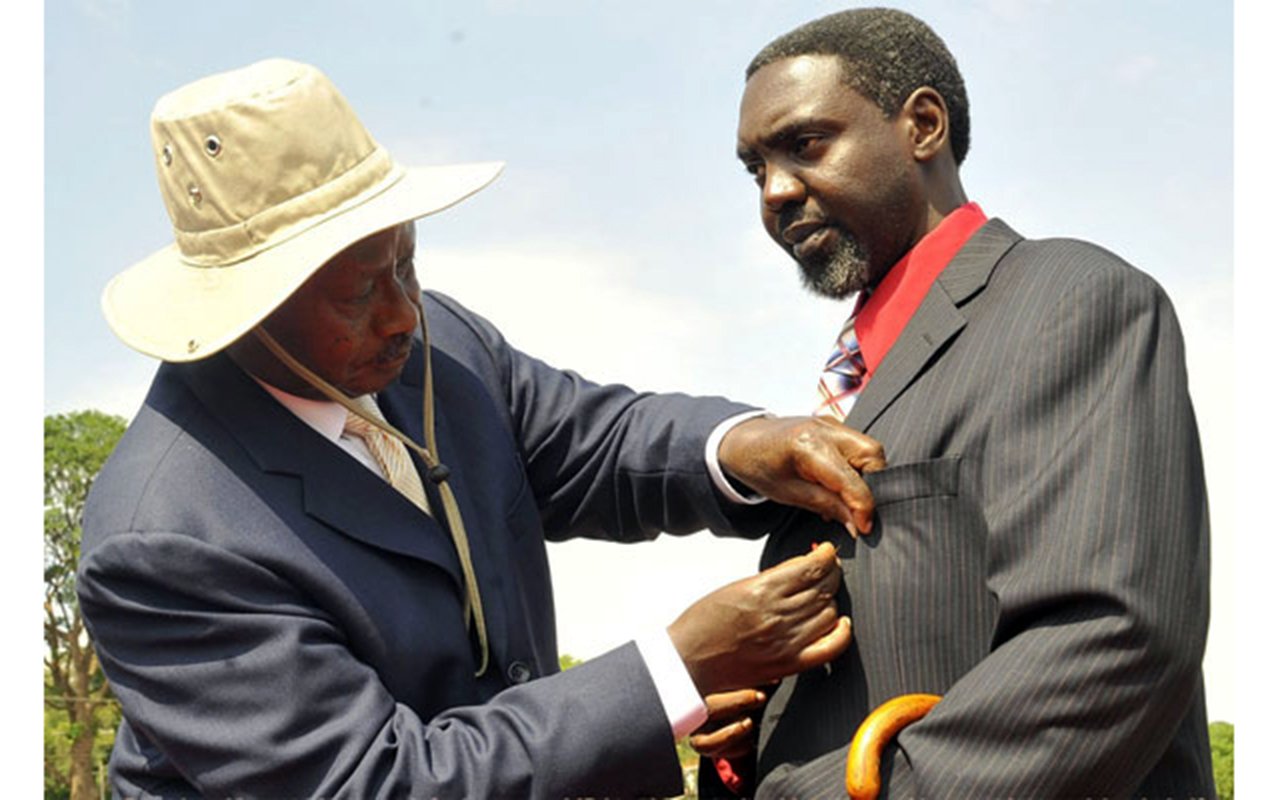Prime
Harvesting immature fish: A vice choking fish industries

A fisherman displays his catch of a Nile Perch at Masese Landing site in Jinja on March 30, 2019. PHOTO/TAUSI NAKATO
What you need to know:
- The fish, which would have grown for processing, are being harvested young by unscrupulous fishermen who take advantage of the government’s poor enforcement of right gear for fishing silverfish.
Fish factories in Kenya, Tanzania and Uganda are operating below installed capacities owing to a sharp drop in fish stocks, especially the Nile Perch.
This, experts say, has plunged the outlook of the fisheries industry across the region into a state of uncertainty amid shrinking exports, falling returns and high production costs.
This uncertainty has been fuelled by catching immature Nile Perch. The fish, which would have grown for processing, are being harvested young by unscrupulous fishermen who take advantage of the government’s poor enforcement of right gear for fishing silverfish (mukene).
While East African member states agreed on larger net sizes in Lake Victoria for fishing mukene (known as dagaa in Tanzania and omena in Kenya), smaller meshed fishing nets are finding their way on the lake in Uganda.
“There is a sharp drop in captured fish supplied to factories,” Mr Dick Nyeko told Monitor, blaming the outcome on fishermen who abandoned the recommended 10mm fishing net mesh size meant for silverfish.
Monitor understands that fishermen on the Ugandan side of Lake Victoria have opted for 4mm nets. These kill non-targeted fish species like Nile Perch and tilapia, reducing their future yield and subsequent recruitment to the fishery.
Small nets, big problems
A 2023 survey report by scientists at the National Fisheries Resources Research Institute (NaFIRRI) confirms a sharp drop in major fish stocks in Lake Victoria. In total, sampled fish species from the lake, including silverfish, Nile Perch and other species, dropped to 2.23 million metric tonnes in 2022.
This was 20 percent lower than what was recorded during the 2021 survey.
“The mean standing stock of Nile Perch was 333,341 tonnes, which is equivalent to annual biomass of 736,683 tonnes. This biomass was 33.72 percent lower than that in 2021, and the reduction was highest in Tanzania and least in Kenya, while Uganda recorded a slight increase in biomass,” the report published in March 2023, indicates.
It adds that the size structure of Nile Perch was dominated by smaller sizes less than 50cm, attributing this to concentrating fishing efforts on big size, especially those above the upper slot size limit of 85cm total length.
The scientists report the mean standing stock of silverfish was 1,060,589 tonnes, which is equivalent to annual biomass of 4,189,327 tonnes. This biomass was 14.3 percent (on average) higher than that from the 2021 survey. The increase was, however, observed only in Uganda. Elsewhere, the Kenyan and Tanzanian portion of the lake recorded a decrease of up to 46.15 percent and 2.53 percent respectively.
According to information from Uganda Fish Processors and Exporters Association (UPEA), on average, most fish factories in Uganda, Kenya and Tanzania are operating at an average of 40 percent. This, UPEA adds, translates to a huge economic loss in the industry.
Now experts warn that, left unchecked, the use of the small-size nets on Lake Victoria could lead to a further plummet in the Nile Perch stock. This is thanks in no small part due to the high percentages of the fish species that are caught in Uganda.
Uganda is well and truly an outlier as information from Lake Victoria Fisheries Organisation indicates that Kenya and Tanzania are not using the 4mm small mesh size nets.
“We believe that type of fishing is very bad, that is why we are telling them to come back to the type of fishing that is allowed by law,” Tom Mukasa Bukenya, the executive secretary of Lake Victoria Fisheries Organisation, told Saturday Monitor.
He suggested that another measure is to allow the lake to cool down, especially during the full moonlight time and during the day.
“We want to eat mukene, which is very nutritious, affordable to many households, [key] ingredient in the animal feed industry, a big employer of youth and women. We believe if mukene is fished in the right way, we can get benefits without compromising other fish species,” he said.
Cost of bad practices
The impact of falling fish volumes caught and increasing demand is felt by average households in Uganda, who have to fork out a lot to afford a kilogramme of Nile Perch.
The price has skyrocketed from Shs300 per kilogramme in 1990 to Shs20,000 per kilogramme in 2024 across most parts of Kampala and its suburbs.
Elsewhere, factories purchase landed fish at Shs17,000 and export it at Shs23,132 ($6 per kilo), leaving them with little leg room for high returns.
Mr Bukenya, who is also the executive director of Lake Victoria Fisheries Organisation (LVFO), said Uganda has not been enforcing the net mesh size regulating the capture of silverfish.
This has ended up costing the region’s fisheries industry dearly. It has also created uncertainty in the industry.
Fish maw threat
But some fisheries industry players also said the growing fish maw industry poses a threat to the population of Nile Perch species. This as parent stocks are sought after to supply the swim bladders to meet a growing global appetite.
According to fisheries officials, while the fisheries regulations in EAC require that parent Nile Perch be reinstated in the lake, illegal means are reported to have cropped in. This is especially prevalent among traders hunting maws, a new cash cow since 2018.
Evidently, changes in the ecosystem, thanks to consequences of climate change, pollution, population growth, and unsustainable fishing practices are threatening the future of fishing in Africa’s largest lake. Over the years, people living near the shores of Lake Victoria have dumped tonnes of single-use items such as polythene bags, plastic bottles, and sachets into the lake. Factories also discharge untreated wastewater and chemicals that contain toxic substances such as lead, arsenic, and aluminium, which harm aquatic life.
Information from Uganda Fisheries and Fish Conservation Association indicates that even though climate change and pollution have affected the breeding cycles of Lake Victoria’s fish, overcapacity fishing remains the biggest culprit.
Per Uganda’s central bank, more than 11 years ending December 31, 2023, the earnings in Uganda’s fish industry have been fluctuating, making planning difficult. From earning $106.9m (Shs412b) in 2013, the sector raked in $176.5m (Shs681b) in 2019 before reducing to $139.8m (Shs539b) in the full year ending December 31, 2023.
The fisheries industry data indicates that at some point, the EAC’s three member states that share Lake Victoria had a total of 36 fish factories, 21 of them, operating in Uganda, but 11 had closed.
Govt intervenes
State actors were finally jolted out of their slumber. In mid-February 2024, the Fisheries State Minister, Ms Hellen Adoa, announced measures intended to save Lake Victoria fish species from getting depleted. She forthwith banned fishing silverfish during daytime or when there is moonlight.
Fishers, according to the minister, had resorted to the “hurry up” method, which uses large fishing nets spreading over large areas and targeting all species of fish on their way and other important diversity.
Unauthorised foreigners were also banned and those found engaging in the practice must be apprehended and dealt with according to the law.
“All responsible departments of fisheries resources both at the centre and local governments and enforcement agencies are instructed to take note of these measures and take appropriate action, including but not limited to further public sensitisation and enforcement,” she said, adding, “My ministry takes sustainable exploitation of this fishery very seriously. This is because we wish to protect and enhance the livelihoods of more than 60 percent of the fishing communities that depend on this fishery.”





